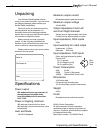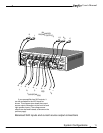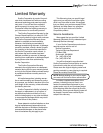
17
User's Manual
Troubleshooting
The Sunfire Cinema Grand Amplifier is
expertly designed and built to provide years of
trouble-free performance. Most problems that
occur can usually be solved by checking your
setup or making sure that the components
connected to the amplifier are on and fully
operational.
The following information will help you
deal with common setup problems you may
experience during normal use of your unit. If
the problems still persist, please contact your
Sunfire Dealer for assistance.
No sound from one or more
speakers
• Speaker cables may have come undone.
Turn off your system and check the cables
• The preamplifier volume level is low for
the channels concerned. Recheck the
preamplifier calibration procedure.
• The preamplifier mute switch is on
• The correct preamplifier surround mode is
not selected
• A tape or external processor loop may be
engaged on the preamp.
Current source outputs not
working
• Check the current source fuse. If it blows
often, it is acceptable to replace with a
slow blow 7 ampere fuse.
The amplifier shuts down often
or the line fuse blows often
• Check that the positive and negative
speaker wires are not shorted.
• Make sure that no speakers are shorted
internally. An ohm-meter should read 2 or
more ohms for most speakers.
• If you have connected speakers in paral-
lel, the overall impedance may be too low.
It is recommended that you rearrange the
speakers in series to increase the overall
impedance, thus taking some of the load
off the amplifier.
Troubleshooting
• Make sure that the amplifier has good
ventilation and is not overheating. Use the
crystal base to allow good airflow under-
neath. If the amplifier is in a closed rack,
open up the rear panel or use a quiet fan
for improved ventilation.
Hum in your speakers
This may be due to a system ground loop,
rather than a problem with the amplifier. Take
the following steps to isolate the cause of any
hum.
Remember to turn off all components in
your system before disconnecting or connect-
ing any cables.
• If your preamplifier has XLR balanced
outputs, use them because they offer
greater immunity to noise fields.
• Try to have all of your equipment on the
same electrical outlet or circuit. Group all
the low power components (preamp, CD
player, DVD etc.) on a single outlet or
power strip. This is provided that the
overall current draw from your equipment
does not exceed the rating of the outlet or
breaker.
• Disconnect all cables which come from
outside of the room, such as cable TV,
satellite TV, or roof top antennas. If the
hum is caused by the cable TV line, then
you will need a “ground loop isolator.” This
is an inexpensive device fitted in line with
the coaxial cable feed, see your TV/video
dealer.
• As a test, disconnect any other component
which has a grounded power cord.
NOTE: Never remove the ground
pin from any power cords. This is
very dangerous.
• If the hum persists, disconnect all the
source components one at a time from the
back of the preamp, until you identify the
problem.


















